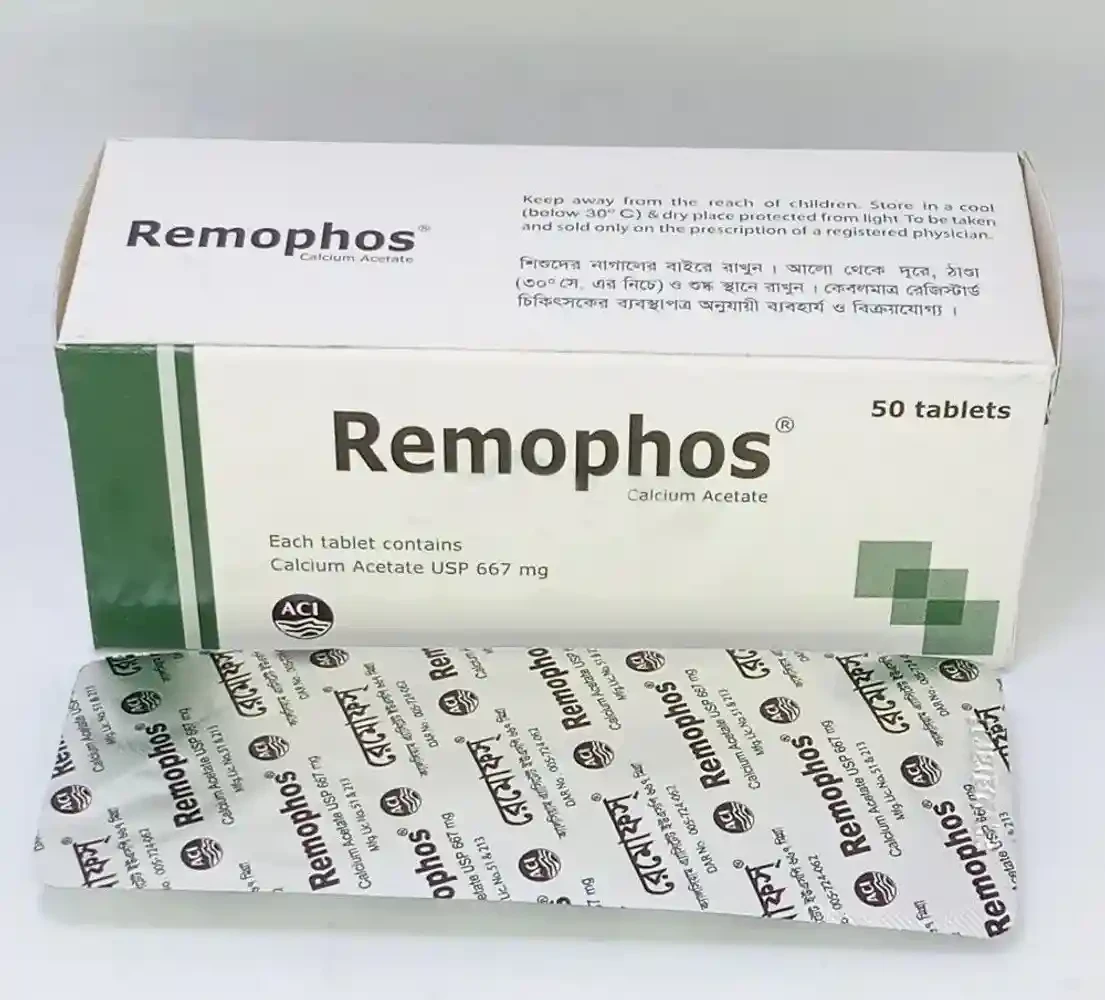Remophos Uses, Dosage, Side Effects and more
Remophos when taken with meals, combines with dietary phosphate to form insoluble Calcium Phosphate which is excreted in the feces. Maintenance of serum phosphorus below 6.0 mg/dl is generally considered as a clinically acceptable outcome of treatment with phosphate binders. Remophos is highly soluble at neutral pH, making the Calcium readily available for binding to phosphate in the proximal small intestine. Orally administered Remophos from pharmaceutical dosage forms has been demonstrated to be systemically absorbed up to approximately 40% under fasting conditions and up to approximately 30% under non fasting conditions. This range represents data from both healthy subjects and renal dialysis patients under various conditions.
Patients with advanced renal insufficiency (creatinine clearance less than 30 ml/min) exhibit phosphate retention and some degree of hyperphosphatemia. The retention of phosphate plays a pivotal role in causing secondary hyperparathyroidism associated with osteodystrophy, and soft-tissue calcification. The mechanism by which phosphate retention leads to hyperparathyroidism is not clearly delineated. Therapeutic efforts directed toward the control of hyperphosphatemia include reduction in the dietary intake of phosphate, inhibition of absorption of phosphate in the intestine with phosphate binders, and removal of phosphate from the body by more efficient methods of dialysis. The rate of removal of phosphate by dietary manipulation or by dialysis is insufficient. Dialysis patients absorb 40% to 80% of dietary phosphorus. Therefore, the fraction of dietary phosphate absorbed from the diet needs to be reduced by using phosphate binders in most renal failure patients on maintenance dialysis. Calcium acetate when taken with meals combines with dietary phosphate to form insoluble calcium phosphate which is excreted in the feces. Maintenance of serum phosphorus below 6.0 mg/dl is generally considered as a clinically acceptable outcome of treatment with phosphate binders. Calcium acetate is highly soluble at neutral pH, making the calcium readily available for binding to phosphate in the proximal small intestine.

| Attribute | Details |
|---|---|
| Trade Name | Remophos |
| Generic | Calcium Acetate |
| Calcium Acetate Other Names | Acetate of lime, Brown acetate of lime, Calcio acetato, Calcium acetate, calcium ethanoate, Gray acetate of lime, Lime acetate, Lime pyrolignite |
| Weight | 667mg |
| Type | Tablet |
| Formula | C4H6CaO4 |
| Weight | Average: 158.166 Monoisotopic: 157.989199835 |
| Groups | Approved, Investigational |
| Therapeutic Class | Drugs for reduction of serum phosphorus in patients with ESRD, Minerals in bone formation, Specific mineral preparations |
| Manufacturer | ACI Limited |
| Available Country | Bangladesh |
| Last Updated: | January 7, 2025 at 1:49 am |
Uses
Remophos is used for the treatment of hyperphosphatemia, control of hyperphosphatemia in end stage renal failure.
Remophos is also used to associated treatment for these conditions: Hyperphosphataemia, High phosphate levels, Astringent, Prophylaxis of bacterial skin infections
How Remophos works
Calcium acetate and other calcium salts are phosphate binders. They work by binding with the phosphate in the food you eat, so that it is eliminated from the body without being absorbed.
Dosage
Adult:Initially 3-4 g daily. Usual range: 6-12 g daily.
To control hyperphosphataemia in chronic renal failure: Initially 1.334 g (338 mg of calcium). May increase dosage gradually according to serum phosphate conc, provided hypercalcaemia does not occur.
Side Effects
In clinical studies, patients have occasionally experienced nausea during Remophos therapy. Hypercalcemia may occur during treatment with Remophos. Mild hypercalcemia (Ca > 10.5 mg/dl) may be asymptomatic or manifest itself as constipation, anorexia, nausea and vomiting. More severe hypercalcemia (Ca>12mg/dl) is associated with confusion, delirium, stupor and coma. The long-term effect of Remophos on the progression of vascular or soft-tissue calcification has not been determined. Isolated cases of pruritus have been reported which may represent allergic reactions.
Toxicity
Oral, rat: LD50 = 4280 mg/kg. Symptoms of overdose include mild hypercalcemia (constipation; loss of appetite; nausea and vomiting), and severe hypercalcemia (confusion; full or partial loss of consciousness; incoherent speech).
Precaution
Patients with end stage renal failure may develop hypercalcemia when given calcium with meals. No other calcium supplements should be given concurrently with Remophos.
Interaction
Remophos may decrease the bioavailability of tetracycline.
Food Interaction
- Take with food. When taken with food, calcium acetate forms an insoluble complex with the phosphorus from food, reducing phosphorus serum concentrations.
Elimination Route
40% is absorbed in the fasting state and approximately 30% is absorbed in the nonfasting state following oral administration.
Elimination Route
Calcium acetate when taken with meals, combines with dietary phosphate to form insoluble calcium phosphate which is excreted in the feces.
Pregnancy & Breastfeeding use
Animal reproduction studies have not been conducted with Remophos. It is not known whether Remophos can cause fetal harm when administered to a pregnant woman or can affect reproduction capacity. Remophos should be given to a pregnant woman only if clearly needed.
There are no adequate studies in women for determining infant risk when using the medication during breastfeeding. Weigh the potential benefits against the potential risks before taking this medication while breastfeeding.
Contraindication
Remophos is contraindicated in patients with hypercalcemia.
Acute Overdose
Administration of Remophos in excess of the appropriate daily dosage can cause severe hypercalcemia.
Storage Condition
Store in a cool & dry place at room temperature. Protect from light, heat & moisture.
Innovators Monograph
Remophos contains Calcium Acetate see full prescribing information from innovator Monograph, MSDS, FDA label



